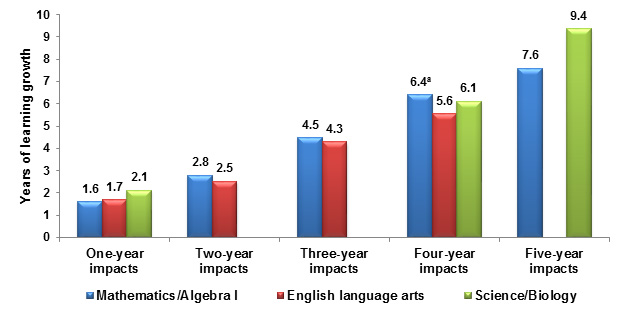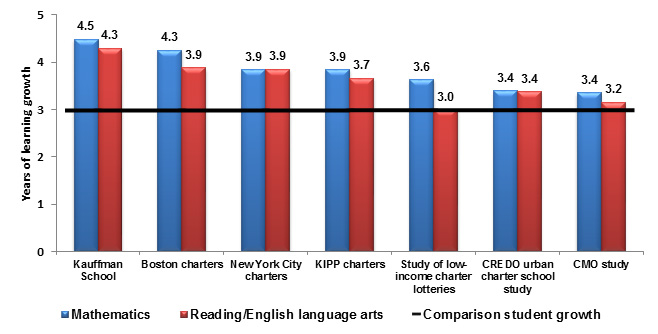Students at the Ewing Marion Kauffman School, a charter school serving low-income families in Kansas City, Missouri, are achieving substantially higher academic growth compared with other public school students in the city, a new study by Mathematica Policy Research finds.
Key findings
As described in a new report, Mathematica’s analysis of data from the Kauffman School’s first five years of operation showed sustained academic growth in math, reading, and science as measured by the state’s standardized tests (see Figure 1). On average, after attending the school for three years, students achieved academic growth equivalent to 4.5 years of learning in math and 4.3 years in English language arts (ELA). By their fourth year, students’ gains in math, ELA, and science reached 6.4 years, 5.6 years, and 6.1 years of learning, respectively. And by their fifth year, students’ years of learning reached 7.6 years in math and 9.4 years in science.
Figure 1. Impacts on Kauffman students represented as years of learning growth

aThe four-year math impact is based in part on imputed outcome data.
Notes: The conversion presented in this figure assumes that students in the comparison group on average achieve one year of learning growth per year.
In addition, before entering the Kauffman School in 5th grade, 36 percent of students scored at the proficient level on the math state assessment and 38 percent scored at the proficient level on the ELA state assessment. After three years of enrollment, students’ proficiency rates average 63 percent in math and 65 percent in ELA. After four years, those rates increase to an average of 84 percent in math and 79 percent in ELA.
Comparisons with other charter schools
- The positive impact of the Kauffman School on its students compares favorably with the average impacts reported in other charter school studies from around the country (see Figure 2).
- The Kauffman School’s three-year impacts are large enough to close about 78 percent of the math black–white test score gap and 66 percent of the ELA black–white test score gap in Kansas City.
Figure 2. Charter school three-year impact estimates from various studies represented as years of learning growth

CMO = Charter Management Organizations; CREDO = The Center for Research on Education Outcomes; KIPP = Knowledge is Power Program
Notes: The figure presents three-year effect-size estimates converted to years of learning growth. This conversion assumes that students in each study’s comparison group on average achieve one year of learning growth per year, as indicated by the black horizontal line.
“The Kauffman School is having a substantial positive impact on student achievement,” said Mathematica Researcher Matthew Johnson, who leads the student outcomes evaluation as part of an ongoing nine-year study of the Kauffman School. “Only about one-third of Kauffman students scored proficient or advanced on the state assessments before entering the Kauffman School. After five years of continuous enrollment, more than 90 percent of Kauffman students scored proficient or advanced.”
Background on the school
The Ewing Marion Kauffman Foundation opened the school in fall 2011 to serve low-income families in its home city, promoting an approach to education that includes high attendance and behavioral expectations, ambitious academic goals, an extended school day and year, extensive professional development for all staff, and increased math and reading instructional time. The school began with a 5th-grade class and is adding a new class each year until it becomes a fully enrolled middle school and high school (grades 5 to 12).
Noting that the Kauffman Foundation is the first grant-making foundation to directly start a charter school in the United States, Claudia Gentile, director of the Kauffman School evaluation, said that Mathematica’s study will provide insights for any organization considering starting a charter school as well as administrators of current charter and general public schools.
“Although other charter schools have used some of the same approaches in various combinations, the Kauffman School’s particular complement of hallmarks is unique,” Gentile said. “This report describes in detail how the school evolved over its first five years and the lessons learned about how to reach and maintain high levels of academic achievement in urban schools and prepare students to succeed in high school and college.”
Moving forward
Mathematica is currently completing the sixth year of the Kauffman School study, which the Kauffman Foundation funds. Mathematica researchers use academic performance data provided by the Kauffman School and the Missouri Department of Elementary and Secondary Education to analyze the impacts of the Kauffman School on student achievement. To learn more about what works at the Kauffman School and about ongoing challenges, the study includes analyses of behavioral impacts; surveys of students, teachers and parents; observations of classroom instruction; focus groups with students and teachers; and interviews with school staff, Kauffman Foundation staff, and parents. As Kauffman students progress through their high school years, the evaluation will begin to assess their college readiness and eventually graduation rate and college matriculation.
In addition to the report on the Kauffman School’s five-year impacts on student achievement, an executive summary of the results is available, as is an issue brief on the school’s hallmarks, and an article summarizing the Kauffman School’s three-year impacts on student achievement.

